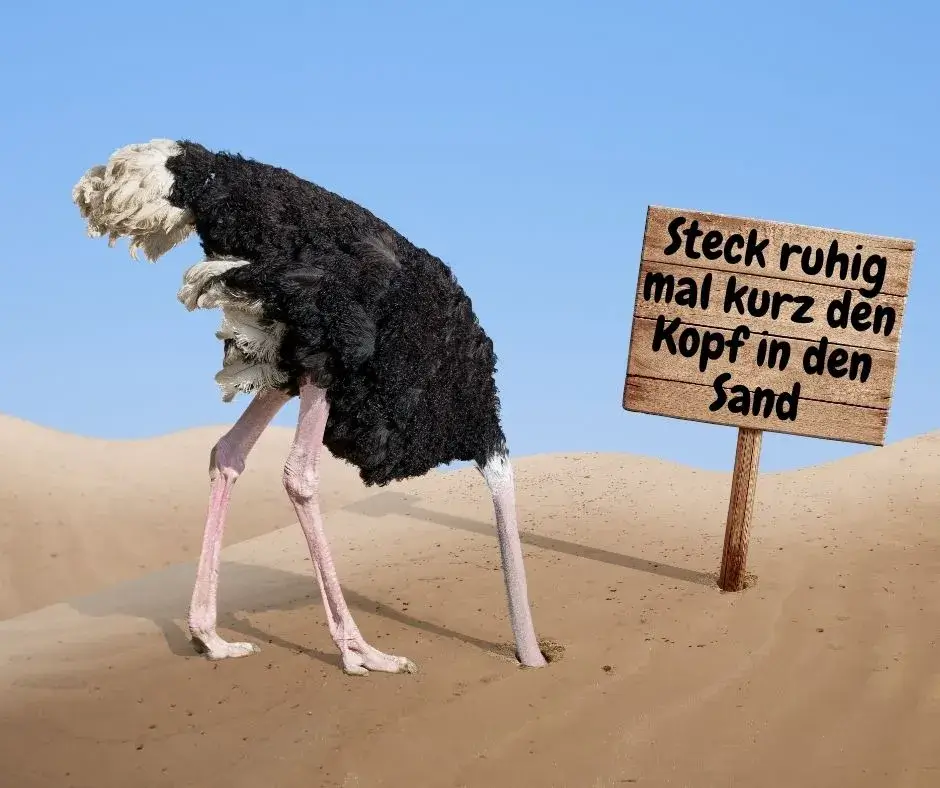To read this article in English, please scroll down. Optimisten sind schlimme Nervensägen. Du denkst jetzt vielleicht: „Moment. Sagst Du nicht selbst immer, wir sollen uns auf die Lösungen fokussieren, weg vom Problem? Ist das nicht das, was Optimisten tun?“ Da hast Du natürlich recht. Das tue ich mit Inbrunst. Ich würde mich selbst allerdings eher als Teilzeit-Optimistin bezeichnen. So mit 80%-Vertrag. (Bei dem man doch irgendwie 100% macht. Aber das ist ein Thema für einen anderen Artikel.) Wovon ich mich ausdrücklich distanzieren möchte, sind diese „Jede Krise ist eine Chance“-Schönredner-Optimisten. Mir geht so eine Rosarot-Mentalität no matter what auf den Geist. Das ist mir zu einseitig, zu kurzsichtig, zu naiv.
Ja, es stimmt, auch ich versuche stets, schnell in den Anpack-Modus umzuschalten. Zu schauen, welche Vorteile sich für mich aus der jeweiligen Krise ergeben könnten. Die neue Ist-Situation anzunehmen und mich anzupassen. Gleichzeitig weiß ich, dass es wichtig ist, einmal kurz inne zu halten und dem unguten Gefühl Raum zu geben, das ganz unbedingt gehört, gesehen und eben gefühlt werden will. Das hat auch viel mit Achtsamkeit zu tun. Vielleicht hast Du das schon mal erlebt: Du fühlst Dich irgendwie und glaubst, dass das nicht okay ist. Und je mehr Du dann gegen dieses Gefühl ankämpfst, desto intensiver, lauter wird es in Dir. Das führt dann meiner Erfahrung nach irgendwann dazu, dass irgendeinem armen Menschen, der zur falschen Zeit am falschen Ort ist, die volle Entladung dieser von uns in die Kiste gepackten Emotion widerfährt.
Was ist eigentlich der Unterschied zwischen Gefühl und Emotion?
Kurzer Exkurs für etwas mehr Klarheit, was diese beiden Begriffe angeht: Emotionen sind angeboren und entstehen im limbischen System. Sie sind eine Reaktion des Nervensystems auf äußere Reize. Fans der TV-Serie „Lie to me“, in der Bösewichte aufgrund ihrer Mikroexpressionen entlarvt werden, wissen, dass die Grundemotionen Wut, Angst, Ekel, Freude, Liebe, Scham, Traurigkeit und Überraschung sind.
Gefühle hingegen entstehen im Frontallappen des Gehirns und basieren auf unserer Interpretation. Das bedeutet, unsere Gefühle können wir beeinflussen – in alle Richtungen. Hart ausgedrückt entscheiden wir uns für unsere Gefühle. Stark vereinfacht erleben wir die Emotion und entwickeln dann ein Gefühl dazu. Eine sehr kraftvolle Achtsamkeitsübung ist deshalb das Labeling, bei dem wir unsere Emotionen wahrnehmen und sie dann in Kategorien einordnen, z.B. durch die Etikettierung (Labeling) „hilfreich“ und „nicht hilfreich“. Allein durch diese kurze Reflexion kann es uns gelingen, das nachfolgende Gefühl zu verändern, falls gewünscht. Um dann achtsam in die Kommunikation zu gehen.
Hyper-Optimismus ist auch nicht besser als Miesepetrigkeit
Ich habe Schwierigkeiten, den Super-Optimisten im lila Glitzeranzug zu glauben, wenn sie so tun, als hätten sie niemals Zweifel. Als gäbe es für sie keine schwarzen Wolken, die mal kurz das Licht am Horizont verdunkeln. Irgendwie finden manche es schick, ihre vermeintlich negativen Emotionen, die aber in Wirklichkeit eine wichtige und achtenswerte Funktion erfüllen, zu negieren. Du kannst das natürlich so machen, wenn es Dir gut damit geht. Ich wage allerdings zu bezweifeln, dass das auf Sicht funktioniert. Genau wie dauerhaftes Gemecker und Gejammer nicht gesund sind, kann Dir sicher auch ein Hyper-Optimismus schaden. Jedenfalls dann, wenn der Schritt der Reflexion der negativ assoziierten Gefühle übersprungen wird. (Lies gern auch nochmal meinen Blog-Post zum Thema Changekurve dazu.) Wir können versuchen, unsere Sorgen, Ängste, Nöte, die sich für uns aus einer Krise ergeben, wegzudrücken. Meine Erfahrung: Die rufen trotzdem immer wieder an.
So wirst Du ein „tempered optimist“
Wie also „gut“ umgehen mit Krisen? Ich habe mir genau angeschaut, wie ich selbst mit Rückschlägen umgehe. Denn nichts anderes ist eine Krise für mich. Und manchmal braucht es genau diesen Rückschlag, damit es erst so richtig nach vorne losgehen kann. Du merkst schon, da kommt jetzt der Optimist in mir durch. Es ist allerdings ein gemäßigter Optimist, den ich sehr schätze. Ein tempered optimist. Für mich ist das eine gelungene Mischung aus Realist und Optimist.
Das geht ungefähr so:
- Der Rückschlag kommt. Du bist im Schock. Lass es zu. Das ist okay und wichtig.
- Du gehst in den Widerstand. Und das sollst Du auch. „Das kann doch wohl nicht wahr sein!“ und „Nicht mit mir!“ sind okay.
- Du merkst, dass „es“ tatsächlich passiert. Und Einfluss auf Dich hat. Jetzt bekommst Du vielleicht Angst. Oder machst Dir Sorgen. Oder beides. Nimm es wahr und geh in die Analyse: Was genau befürchtest Du? Bau Dir ruhig ein richtiges (bewusst übertriebenes) Horror-Szenario. Das nennt sich produktive Paranoia und bringt Dich am Ende vielleicht sogar zum Lachen, weil es so absurd wird.
- Durch das Horror-Szenario geht es Dir jetzt vielleicht echt nicht gut. Nur: Das ist ja eh in Dir drin. Wenn Du es also rauslässt wie ein Monster aus der Kiste, kannst Du es schneller bearbeiten. Vielleicht ist es gar kein Monster?
- Jetzt ist es Zeit für den gesunden Optimismus:
- Angenommen, diese Krise hat auch Vorteile für mich. Welche könnten das sein?
- Was will ich lernen?
- Was ist jetzt wirklich wichtig – in meinem Business, privat?
- Worin will ich jetzt investieren?
- Jetzt kannst Du Dich entscheiden: Willst Du die Vorteile der Krise für Dich nutzen oder nicht?
- Wenn Du Dich dafür entscheidest (und davon gehe ich jetzt einfach mal aus, ansonsten hättest Du vermutlich gar nicht bis hierhin gelesen), kannst Du jetzt die Neuerungen in Dein tägliches Tun integrieren. Vielleicht ist das auch schon längst geschehen und Du fragst Dich, weshalb Du erst die Krise brauchtest, um das zu erkennen. Mir geht das unbedingt so, besonders mit allem, was ich digital so mache. Zum Beispiel gäbe es diesen Blog ohne die Krise vielleicht nicht.
Ich ermuntere Dich, die für Dich passende Dosis Optimismus zu finden. Für mich ist es mit dem Optimismus ähnlich wie mit Mut: Mut heißt Handeln, obwohl Du Angst hast. Optimismus ist eng mit Mut verbandelt. Also braucht es erst die Unsicherheit, den Kopf im Sand, bevor ich ihn wieder rausstrecken und optimistisch in die Zukunft blicken kann. Wichtig ist, dass Du nicht da unten stecken bleibst.
Bis nächsten Freitag. Bleib klar!
Deine Saskia

Optimists are a pain in the ass. You might be thinking now, „Wait a minute. Don’t you always say yourself to focus on the solutions, away from the problem? Isn’t that what optimists do?“ Of course, you are right. I do so with fervor. But: I prefer to call myself a part-time optimist, however. With an 80% contract. (Which somehow still means 100%. But that’s a topic for another article.) What I would like to distance myself from are the „every crisis is an opportunity“-predicting optimists. This „everything-is-pink-no-matter-what-mentality“ drives me nuts. That’s too one-sided, too short-sighted, too naive for me.
Yes, it’s true, I always try to switch quickly into tackle mode too. To see what advantages could arise for me from the respective crisis. To accept the new current situation and to adapt. At the same time, I know that it is important to pause for a moment and give room to the unpleasant feeling that absolutely needs to be heard, seen and felt. It also has a lot to do with mindfulness. You may have experienced this before: You feel something and believe that it is not okay to feel like that. And the more you fight against this feeling, the more intense, the louder it gets inside you. In my experience, that leads to a full and unexpected discharge of this box of emotions toward some poor person who happens to be in the wrong place at the wrong time.
What is the difference between feeling and emotion?
Short digression for a little more clarity regarding these two terms: Emotions are innate and arise in the limbic system. They are a reaction of the nervous system to external stimuli. Fans of the TV series „Lie to me“, in which villains are exposed because of their micro-expressions, know that the basic emotions are anger, fear, disgust, joy, love, shame, sadness and surprise.
Feelings, on the other hand, arise in the frontal lobe of the brain and are based on our interpretation. This means that we can influence our feelings – in all directions. In harsh terms, we choose our feelings. In a very simplified way, we experience the emotion and then develop a feeling for it. A very powerful mindfulness exercise is therefore labeling, in which we perceive our emotions and then classify them into categories, e.g. „helpful“ and „not helpful“. Just through this brief reflection we can manage to change the following feeling, if desired. In order to then go into communication mindfully.
Hyper optimism is no better than grumpiness
I have trouble believing the super optimists in the purple glitter suits when they pretend they never have doubts. As if there weren’t any black clouds that could briefly darken the silver lining. Somehow some find it smart to negate their supposedly negative emotions, which in reality fulfill an important and respectable function. You can of course do it like this if it works for you. However, I doubt that it will work in the long run. Just as constant bitching and whining is not healthy, hyper-optimism can certainly hurt you too. At least when the step of reflecting on the negatively associated feelings is skipped. (Feel free to read my blog post about the change curve again.) We can try to decline our worries, fears, and needs that arise for us from a crisis. My experience: They keep calling anyway.
How to become a tempered optimist
So how do you deal „well“ with crises? I took a close look at how I deal with setbacks myself. Because that is what a crisis is for me. Nothing more. And sometimes it takes exactly this setback so that things can really get going. You can already see that the optimist in me is now coming through. It is, however, a moderate optimist that I really appreciate. A tempered optimist. For me it’s a successful mixture of realist and optimist.
It goes something like this:
- The setback is coming. You are in shock. Let it happen. That’s okay and important.
- You go into resistance. As you should. „That cannot be true!“ and „Forget about it!“ are okay.
- You realize that „it“ is actually happening. And has an influence on you. Now you may be scared. Or worried. Or both. Perceive it and go into the analysis: What exactly do you fear? Feel free to build a real (deliberately exaggerated) horror scenario. This is called productive paranoia, and it might even make you laugh in the end because it gets so absurd.
- The horror scenario might make you feel really bad now. Only: That’s inside you anyway. So if you let it out like a monster out of the box, you can process it faster. Maybe it turns out not to be a monster at all?
- Now is the time for healthy optimism:
- Suppose this crisis also has advantages for me. Which could it be?
- What do I want to learn?
- What is really important now – in my business, privately?
- What do I want to invest in now?
- Now you can decide: Do you want to use the advantages of the crisis for yourself or not?
- If you decide to consider the advantages (and I am assuming that you do, otherwise you probably would not have read this far), you can now integrate the innovations into your daily activities. Perhaps it’s already happened and you are wondering why you needed the crisis to get moving. I definitely feel that way, especially with everything I do digitally now. For example, this blog might not exist without the crisis.
I encourage you to find the right dose of optimism for you. For me, optimism is similar to courage: Courage means action, although you are afraid. Optimism is closely related to courage. So it takes uncertainty first, my head in the sand, before I can stick it out again and look optimistically into the future. The important thing is that you don’t get stuck down there.
Until next Friday. Stay clear!
Yours, Saskia



